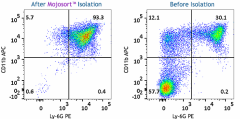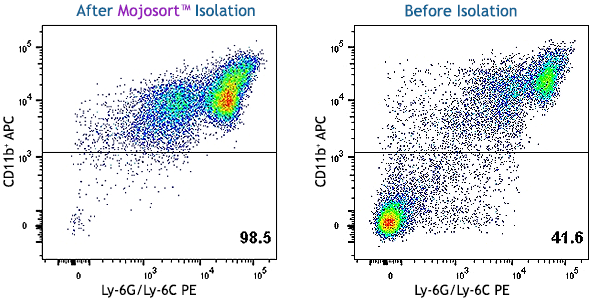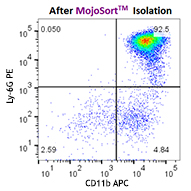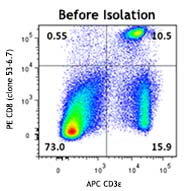- Regulatory Status
- RUO
- Ave. Rating
- Submit a Review
- Product Citations
- publications

-

A single cell suspension from C57BL/6 bone marrow was prepared for the positive selection of Ly-6G+ cells using the MojoSort™ Mouse Ly-6G Selection Kit. Cells were stained with anti-mouse Ly-6G (clone 1A8) PE and anti-mouse/human CD11b (clone M1/70) APC. Dead cells were excluded by Helix NP™ Blue. Left plot: Ly-6G+ cells after isolation. Right plot: Cells before isolation.
| Cat # | Size | Price | Save |
|---|---|---|---|
| 480123 | 20 tests | ¥56,100 | |
| 480124 | 200 tests | ¥166,760 |
Mouse Ly-6G+ cells are either selected or depleted by incubating the sample with a biotin conjugated anti-mouse Ly-6G antibody and magnetic Streptavidin Nanobeads. The magnetically labeled fraction is retained by the use of a magnetic separator. After collection of the Ly-6G+ expressing cells, downstream applications include functional assays, gene expression, phenotypic characterization, etc.
MojoSort™ reagents are also compatible with column-based cell separation systems available from other vendors. Optimized protocols for cell separation using columns from in-house testing are provided for each kit under the “Related Protocols” section, as well as representative data on the product webpage (where available). Data generated using column separators are indicated on the figure legend.
Due to the property of the beads, MojoSort™ reagents typically require dilution for optimal use on column separators. Where available, recommended dilution factors for each kit component based on in-house testing are provided under the “Application Notes” section of the webpage.
Kit Contents
- Kit Contents
-
For Cat. No. 480123:
- 1 vial containing 200 µl of Biotin anti-mouse Ly-6G antibody (clone 1A8)
- 1 vial containing 200 µl Streptavidin Nanobeads
For Cat. No. 480124:- 2 vials containing 1 ml each of Biotin anti-mouse Ly-6G antibody (clone 1A8)
- 2 vials containing 1 ml each of Streptavidin Nanobeads
Product Details
- Verified Reactivity
- Mouse
- Formulation
-
Antibody: Phosphate buffer solution containing 0.09% sodium azide, 0.5% BSA, pH 7.2 with stabilizer.
Streptavidin Nanobeads: Streptavidin Nanobeads: Aqueous solution containing 0.05% sodium azide and 0.3% BSA. - Preparation
-
The antibody was purified by affinity chromatography, and conjugated with biotin under optimal conditions.
Conjugated nanobeads: Protein-coated magnetic beads. - Storage & Handling
- All components should be stored undiluted between 2°C and 8°C.
- Application
-
Cell Separation (MojoSort™) - Quality tested
- Recommended Usage
-
10 µl of Biotin anti-mouse Ly-6G antibody for 1 x 107 cells in 100 µl of buffer.
10 µl of Streptavidin Nanobeads for 1 x 107 cells in 100 µl of buffer. - Application Notes
-
This kit is designed for the positive selection or depletion of mouse Ly-6G+ cells from lymphoid tissue.
Each lot has been individually optimized. Do not mix and match components from different lots or different kits.
Antibody or cocktail dilution to use in column: 5X
Nanobead dilution to use in columns: 5X - Product Citations
-
Antigen Details
- Biology Area
- Immunology, Innate Immunity
- Gene ID
- NA
- UniProt
- View information about Ly-6G on UniProt.org
Related Pages & Pathways
Pages
Related FAQs
- Is there a way to detach your magnetic particles from the cell surface?
-
MojoSort™ Nanobeads: These magnetic particles cannot be removed from cells. This includes standalone Nanobeads and MojoSort kits using Nanobeads. We have found that cells are functional without the need to detach the magnetic Nanobeads.
MojoSort Microbeads: These magnetic particles may be released following the detailed product-specific protocol.
- What is the size of your magnetic particles?
-
MojoSort Nanobeads: the average diameter is approximately 130 nm.
MojoSort Microbeads: the average diameter is approximately 1 μm.
- Are MojoSort™ Nanobeads compatible with other commercially available magnetic separation systems?
-
MojoSort™ magnetic particles can be used with other commercially available magnetic separators, both free standing magnets and column-based systems. Because MojoSort™ protocols are optimized for the MojoSort™ separator, the protocols may need to be adjusted for other systems. Please contact BioLegend Technical Service for more product-specific information and guidance. We do not recommend using MojoSort™ particles for BD’s IMag™ or Life Technologies’ DynaMag™.
- What antibodies are present in the depletion cocktails provided for isolation kits?
-
Please contact our technical service team for further assistance.














Follow Us